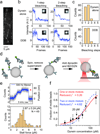The mammalian dynein-dynactin complex is a strong opponent to kinesin in a tug-of-war competition
- PMID: 27454819
- PMCID: PMC5007201
- DOI: 10.1038/ncb3393
The mammalian dynein-dynactin complex is a strong opponent to kinesin in a tug-of-war competition
Abstract
Kinesin and dynein motors transport intracellular cargos bidirectionally by pulling them in opposite directions along microtubules, through a process frequently described as a 'tug of war'. While kinesin produces 6 pN of force, mammalian dynein was found to be a surprisingly weak motor (0.5-1.5 pN) in vitro, suggesting that many dyneins are required to counteract the pull of a single kinesin. Mammalian dynein's association with dynactin and Bicaudal-D2 (BICD2) activates its processive motility, but it was unknown how this affects dynein's force output. Here, we show that formation of the dynein-dynactin-BICD2 (DDB) complex increases human dynein's force production to 4.3 pN. An in vitro tug-of-war assay revealed that a single DDB successfully resists a single kinesin. Contrary to previous reports, the clustering of many dyneins is not required to win the tug of war. Our work reveals the key role of dynactin and a cargo adaptor protein in shifting the balance of forces between dynein and kinesin motors during intracellular transport.
Conflict of interest statement
The authors declare no competing financial interests.
Figures




References
-
- Burgess SA, Walker ML, Sakakibara H, Knight PJ, Oiwa K. Dynein structure and power stroke. Nature. 2003;421:715–718. - PubMed
-
- Torisawa T, et al. Autoinhibition and cooperative activation mechanisms of cytoplasmic dynein. Nat. Cell Biol. 2014;16:1118–1124. - PubMed
-
- Wang Z, Sheetz MP. One-dimensional diffusion on microtubules of particles coated with cytoplasmic dynein and immunoglobulins. Cell Struct. Funct. 1999;24:373–383. - PubMed
MeSH terms
Substances
Grants and funding
LinkOut - more resources
Full Text Sources
Other Literature Sources
Miscellaneous

